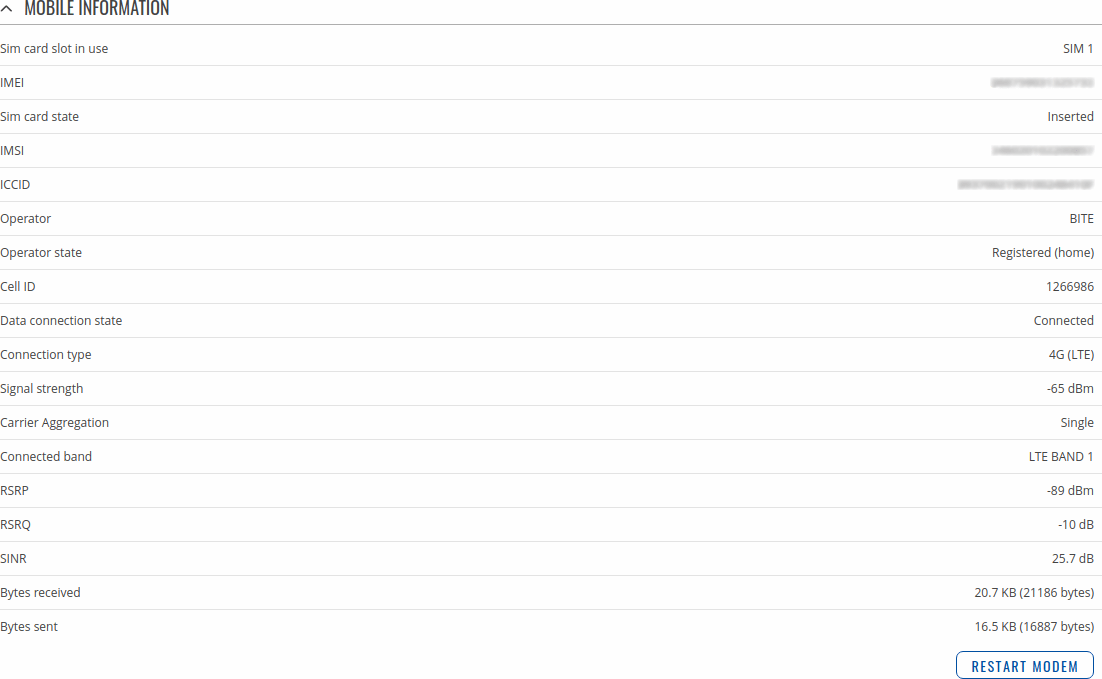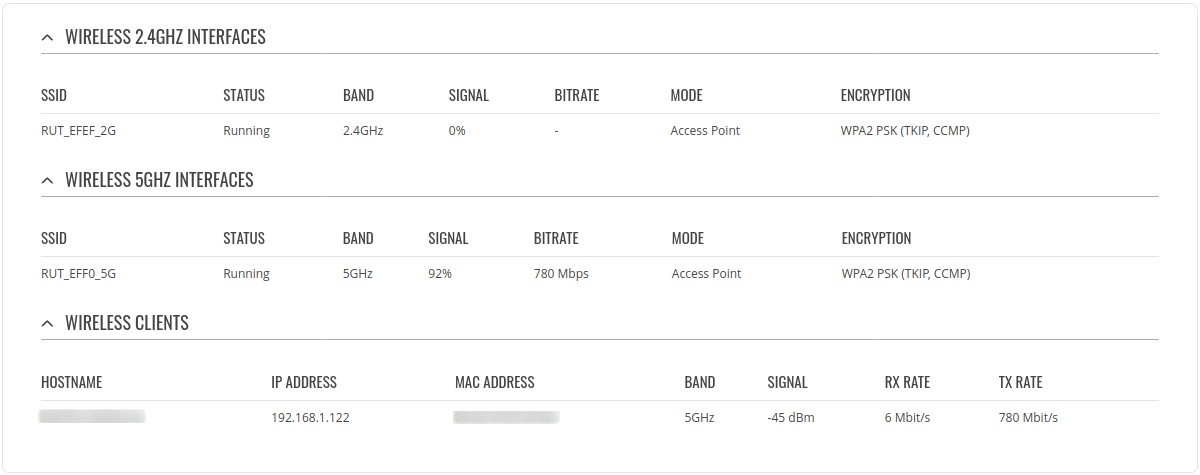Template:Networking rutos manual network
Summary
The Network page contains information related to the device's networking. This chapter is an overview of the Network page in {{{name}}} devices.
The information in this page is updated in accordance with the RUTX_R_00.02.03 firmware version.
LAN
This tab displays information about the device's local network(s). The figure below is an example of the Network window:

| lan information | |
|---|---|
| Name | LAN interface name |
| IP address | IP address of the LAN interface |
| Netmask | Netmask of the LAN interface. In a sense, a netmask specifies the size of a network. In other words, it indicates which part of the IP address denotes the network, and which denotes the device |
| dhcp leases | |
| Hostname | Hostname of a LAN client |
| IP address | IP address of a LAN client |
| MAC address | MAC address of a LAN client |
| Leasetime remaining | Remaining lease time for a DHCP client. Active DHCP lease holders will try to renew their DHCP leases after a half of the lease time passes. |
Mobile
The Mobile tab displays information about the mobile connection. The figure below is an example of the Mobile tab:

| field name | description |
|---|---|
| Sim card slot in use | Shows which sim card slot is currently in use |
| IMEI | The IMEI (International Mobile Equipment Identity) is a unique 15 decimal digit number used to identify mobile modules. GSM network operators use the IMEI to identify devices in their networks |
| SIM card state | The current SIM card state. Possible values are:
|
| IMSI | The IMSI (international mobile subscriber identity) is a unique 15 decimal digit (or less) number used to identify the user of a cellular network |
| ICCID | SIM card's ICCID - a unique serial number used to identify the SIM chip |
| Operator | Network operator's name |
| Operator state | Shows whether the network has currently indicated the registration of the mobile device. Possible values are:
|
| Cell ID | The ID of the cell that the modem is currently connected to |
| Data connection state | Indicates whether the device has a mobile data connection or not |
| Connection type | Mobile connection connection type. Possible values are:
|
| Signal strength | Received signal strength indicator (RSSI) measured in dBm. Values closer to 0 indicate a better signal strength |
| Carrier Aggregation | LTE Advanced Carrier Aggregation, CA, is one of the key techniques used to enable the very high data rates of 4G to be achieved.
By combining more than one carrier together, either in the same or different bands it is possible to increase the bandwidth available and in this way increase the capacity of the link. |
| Connected band | Currently used frequency band. For more information on supported frequency bands |
| RSRP | Reference signal received power, measured in dBm. Values closer to 0 indicate better signal strength |
| RSRQ | Reference signal received quality, measured in dB. Values closer to 0 indicate a better rate of information transfer |
| SINR | Signal-to-interference-plus-noise ratio, measured in dB. Higher values indicate a better rate of information transfer |
| Bytes received | Amount of data received through the mobile interface |
| Bytes sent | Amount of data sent through the mobile interface |
| Restart Modem | Restarts the devices module |
Wireless
| Field name | Description |
|---|---|
| SSID | The broadcasted SSID (Service Set Identifier) of the wireless network |
| Wireless MAC | The MAC (Media Access Control) address of the access point radio |
| Band | The band defines which frequency used |
| Signal | The signal quality between router's radio and some other device that is connected to the router |
| Bit rate | The maximum possible physical throughput that the router's radio can handle. Bit rate will be shared between router and other possible devices which connect to local Access Point (AP) |
| Mode | Connection mode. Can either be Access Point (AP) or Client. In AP mode others can connect to this router's wireless connection. In client mode router connects to other wireless networks |
| Encryption | The type of WiFi encryption used |
| Hostname | Device's hostname |
| IP address | Shows what IP address leased for device |
| MAC address | Device's MAC (Media Access Control) address |
| Signal | Received Signal Strength Indicator (RSSI). Signal's strength measured in dBm |
| RX rate | The rate at which packets are received from associated interface |
| TX rate | The rate at which packets are sent to associated interface |
[[Category:{{{name}}} Status section]]

